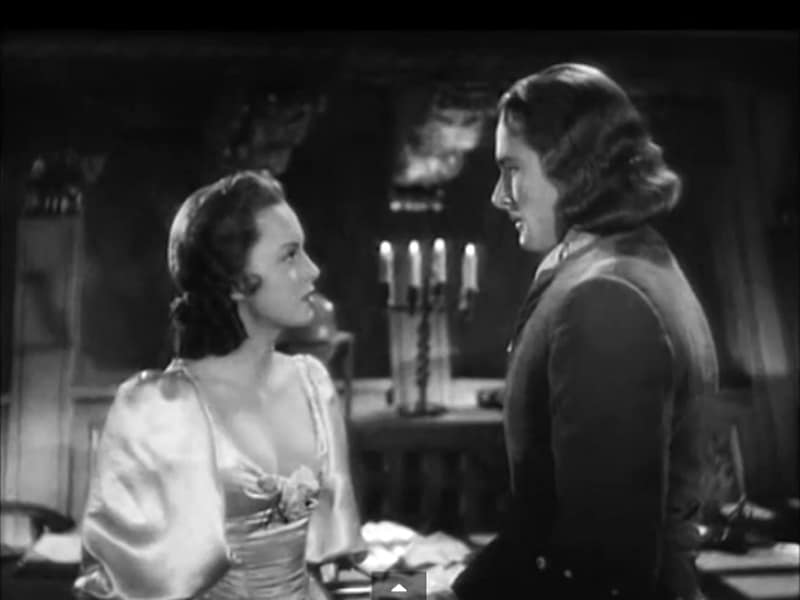
Every week, Film School Rejects presents a movie that was made before you were born and tells you why you should like it. This week, Old Ass Movies presents Captain Blood, from 1935.
Errol Flynn. Olivia de Havilland. If I haven’t sold you on Captain Blood yet, I’ll throw in Basil Rathbone as a pirate. Better yet, I should just let the original tagline for the film sell you on it: “THE MOST MAGNIFICENT & THRILLING SEA ADVENTURE EVER FILMED.”
Hyperbolic advertising aside, it’s an exciting film featuring the incredible acrobatics of Errol Flynn that holds up well today either because of or in spite of the recent love of all things pirate. It’s epic, romantic, bloody. The cinematography is gorgeous, and the action/fight sequences are ahead of their time. It was the first film to feature Flynn and de Havilland together (they would make eight films together), it was nominated for Best Picture (as if I planned writing this for Oscar night), and as a testament to the directing skills of Michael Curtiz – he received the second-highest amount of votes from the Academy that year despite not being on the ballot.
Captain Blood tells the story of Dr. Peter Blood who is charged with treason after giving medical aid to a friend who happens to have been part of a rebellion. He’s punished by being sold into slavery, he’s bought by the governor of Port Royal’s niece, Arabella Bishop (de Havilland), but he soon escapes with several other slaves. The obvious post-slavery choice is to steal a Spanish galleon and become a pirate. This turns out to be a brilliant career choice as the governor is set on quelling the pirate attacks in Port Royal. All of these personal vendettas build in the background of a French attack on the colony where Blood has to fight for the crown — proving his loyalty to the country and winning the hand of Arabella.
There’s a lot going on in this film – so much so that it’s difficult to give a succinct synopsis. It’s ultimately a tale about a man falsely imprisoned and bent on regaining his good name as well as doing what’s right. In a way, it’s a prototype for films like Spartacus or Gladiator except it’s at sea. But it’s also an odd love story and a revenge film that sees the hero fight for his country while rebelling against the injustices of its government.
As to be expected from an Errol Flynn movie, there are a lot of opportunities to showcase the raw physicality of a man who could climb up a topsail faster than most of us can get off the couch to pour more cheese on our nachos. The result is a series of fight scenes that are still jaw-dropping on repeat viewing.
There are a lot of comparisons between this movie and the Robin Hood story (the adaptation of which Flynn and de Havilland would also co-star in) because Flynn’s character is a universal figure of rebellion for what’s right. He’s charming and quick-witted, but he’s rough around the edges. He plays fast and loose with ethics when they don’t really matter, but for all the important things in life he’s steadfast in being a man of honor. Likewise, the movie itself is a sort of conflation of traits – flowing smoothly between comedy, intense action, and romance.
All of this is elevated by the acting abilities of and natural chemistry between Flynn and de Havilland who were complete unknowns at the time. The former plays the dashing leading man with ease, and the latter gives depth to an otherwise usual damsel-in-distress-who-purchases-her-love-interest-as-a-slave archetype. The inclusion of the classical acting brilliance of Basil Rathbone who plays a sort of ruthless kidnapping pirate also strengthens the richness of the characters.
It’s obviously done on a lower budget, but the film stretches the dollars quite a bit – probably saving money by not having to hire a stunt actor for Flynn. Plus, the cinematography work by Ernest Haller and Hal Mohr is strong enough to make the film seem deceptively expensive. The framing of their shots isn’t anything revolutionary, but the shot choices they make for the pirate fight scenes shifts between sprawling full-ship shots of havoc to close-up shots of individuals lunging swords into men just off screen. There’s also a very memorable shot of Blood swinging on a rope directly toward the camera, touching down on the ship deck and getting straight to the fight.
Overall, Captain Blood is an amazing film that launched the careers of two leading icons, brings a rich story of a wronged man trying to do what’s right, and involves pirates. If the title alone doesn’t sell you, you may need to have your pulse checked. It could easily go head to head against several action/adventure stories from the past ten years and win most of those match-ups.
Related Topics: Old Ass Movies

